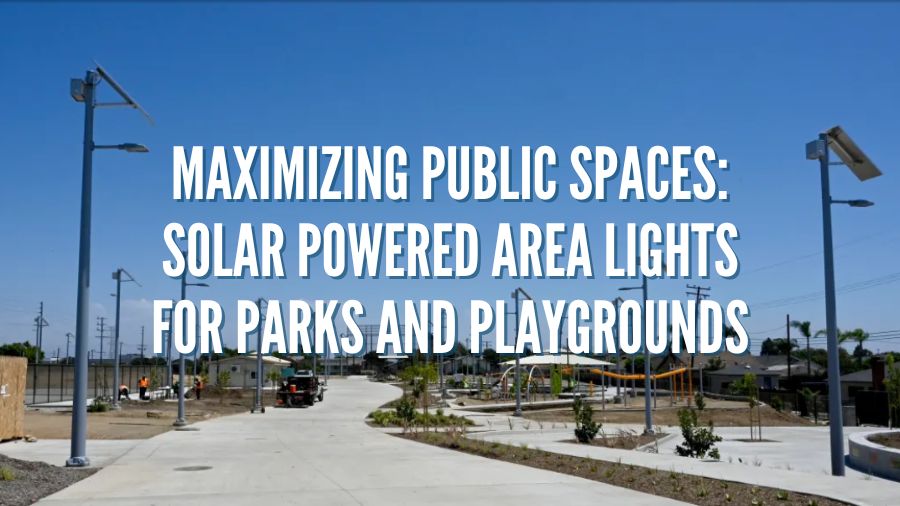


Discover the transformative impact of incorporating solar powered area lights in public parks and playgrounds, revolutionizing community spaces and championing sustainable practices. By harnessing the power of the sun, these innovative lighting solutions not only illuminate these areas but also symbolize a commitment to environmental stewardship and a greener future. Join us as we delve into the myriad benefits that solar lighting brings to enhance community spaces and promote sustainability.
Public parks and playgrounds are essential community spaces that provide opportunities for recreation, relaxation, and social interaction. However, these spaces are often underutilized after dark due to inadequate lighting. This is where solar powered area lights come in, offering a cost-effective and sustainable solution to enhance these community spaces.
By installing solar powered area lights, parks and playgrounds can extend their operating hours, allowing residents to enjoy these spaces even during the evening. This not only maximizes the utilization of public areas but also fosters a sense of community and promotes active lifestyles.
Moreover, solar lighting eliminates the need for traditional grid-connected lights, reducing the reliance on fossil fuels and decreasing carbon emissions. This promotes environmental responsibility and aligns with the growing demand for sustainable practices in communities.
One of the major advantages of solar powered area lights is their cost-effectiveness for parks and recreation departments. Traditional lighting systems can be expensive to install and maintain, requiring extensive electrical infrastructure and ongoing energy costs. In contrast, solar lighting systems harness the power of the sun, providing a renewable and free source of energy.
By utilizing solar powered area lights, parks and recreation departments can significantly reduce their energy expenses, freeing up funds that can be allocated to other important projects and maintenance tasks. Additionally, solar lights require minimal maintenance, as they do not have complex wiring or moving parts, resulting in further cost savings for the department.
Well-lit public spaces contribute to the safety and security of communities. Solar powered area lights provide bright and reliable illumination, enhancing visibility and deterring potential criminal activities in parks and playgrounds.
Furthermore, the installation of motion sensors or adaptive lighting controls can further improve safety and security while optimizing energy usage. These technologies ensure that the lights only operate when the space is being used, eliminating the wasted energy on lights that are too bright or operate long after closing when they are no longer necessary.
By strategically placing solar lights with motion sensors or adaptive controls, parks and playgrounds can create a safer environment for residents, making these public spaces more inviting and accessible even during the nighttime.
In order to maximize energy efficiency and reduce costs, it is important to specify solar lighting systems that incorporate motion sensors or adaptive lighting controls.
Motion sensors detect movement and activate the lights only when someone is present in the area. This eliminates the need for continuous lighting and ensures that energy is not wasted when the space is not in use.
Adaptive lighting controls adjust the brightness of the lights based on the surrounding conditions. This prevents the lights from being too bright, which can cause light pollution and disturb nearby residents. Additionally, adaptive controls can also regulate the operating hours of the lights, preventing them from operating for an unnecessary amount of time.
By implementing these technologies, parks and playgrounds can optimize their energy usage, reduce operational costs, and contribute to a more sustainable and eco-friendly community.
Solar powered area lights align with the growing demand for sustainable practices and environmental responsibility. By harnessing the power of the sun, these lights operate using clean and renewable energy, reducing the dependence on fossil fuels and decreasing greenhouse gas emissions.
In addition to their environmental benefits, solar lighting systems also contribute to the overall sustainability of communities. By extending the operating hours of public spaces, they encourage outdoor activities and promote a healthier lifestyle. This has positive impacts on the physical and mental well-being of residents, fostering a stronger sense of community and enhancing the overall quality of life.
By investing in solar powered area lights for parks and playgrounds, communities demonstrate their commitment to sustainability and create a brighter and greener future for generations to come.
Photo Ref: Wishing Tree Park
